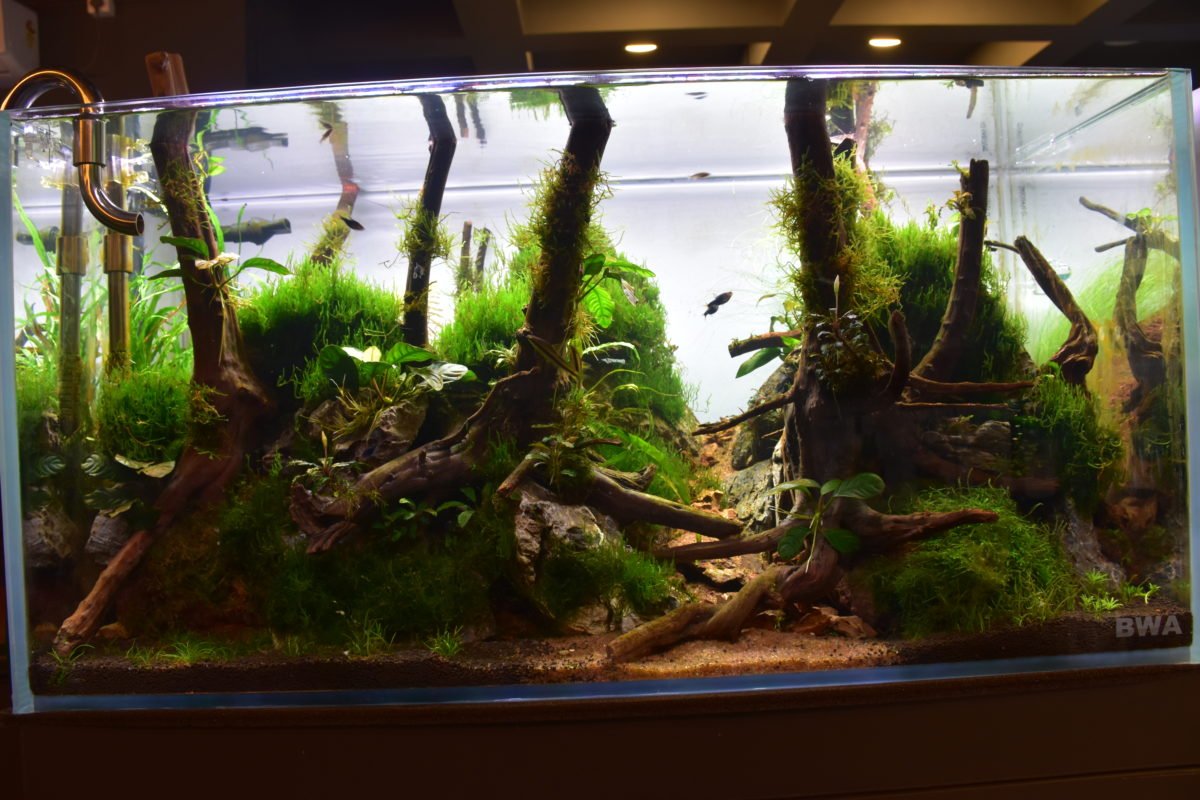This is achieved by recreating or imitating a landscape, nature style is preferred by most, for its comprehensive use of materials. Although difficult to pull off, this style has the reputation of winning awards for its hobbyists. Different materials such as rocks, stones, sand, plant and fish come into play. Let us look into the requirements of nailing a nature aquarium.
There are 3 layouts used in a nature aquarium:
- Concave: The primary focus of this layout is to bring in a centre point object; that could be using either driftwood, stones, rocks etc and gently increase in height (towards the sides of tank) with tall growing plants. This layout brings in natural setting such as caves, valleys, roads, hills, pathways etc.

- Convex: Unlike the concave, this layout uses masses of rocks, stones, driftwood to create height as the center point; and as we progress towards the sides of the tank, the height decreases. Placing sand around the center piece, one can mimic an island.

- Triangle: Using high raising focal point, starting from either side of your tank that and decreases as you move towards the substrates level is the feature of a triangle layout. So, when using plants for this layout; start from tallest and finish off with shortest plants.

The Tank in use:
Tanks from as small as 5 gallons to as large as 50 gallons and above will accommodate nature style. The size of the tank doesn’t hinder in showing off of your design. Hence chose a tank that fits your budget. Click here to browse through our tanks.
The light in use:
This entirely depends on the plants you use. If you have low demanding plants, a decent LED would do. A lower light would mean easy maintenance. Either way, make sure you can adjust the intensity of lights, should you see those slimy green, unwanted visitors. For more details on light Click Here.
The Soil, Substrate & Fertilizer:
For the soil hungry plants, you can use aqua soils, which would also aid the carpeting plants if you include them in your layout. A good quality substrate and nutrient rich plant feed is very important; sands can also be used to theatre the effect of an island. Browse for our options on soil, substrate and fertilizer.
CO2 Injection:
They are necessary if you incorporate multi colour plants. A well monitored CO2 injection is vital to sustain the layout. Without CO2 it would take time for the plants to mature and grow to reach your desired effect. View our CO2 set up Right Here.
Filtration:
A good flow of nutrients and CO2 is attained with the right filtration system. Invest in an appropriate filter that fits the size of your tank. Some seek the aid of water pump to get the additional circulation going. Click here to view filtration system.
Hardscape:
The nature style highly depends on hardscapes such as rock, stone, driftwoods etc. Never forget that the hardscape you use will be the foundation of your nature scape. This acts as the central character that frames your scene and a vital tool to create volume/depth to your tank. Keep in mind that the bigger the tank, the more hardscape you will need which in turn means the more expensive it gets. So, if you are a beginner, we would suggest you to start with a small to medium size tank.
Fishes and Shrimps:
Similar to Dutch style, you can add a school of fish such as glow-light tetras, ember tetras, harlequin rasboras. Consider one or two different types of species. There are hobbyists who include fishes like angel, gouramis and discus . If you want to highlight your tank beauty, without fishes, you can depend on invertebrates such as amano shrimps, red cherry shrimps, neocaridina and cardina
Selection of Plants:
- For carpet/foreground– Marsilea Crenata, Marsilea Hirsuta, Elatine Tiandra, Lilaeopsis, Mauritiana, Dwarf Hairgrass Hydrocotyle Tripartita etc
- Midground plants– Jungle val, Hygrophila Polysperma, Hygrophila Difformis, Water Sprite, Amazon Swords, Nymphaea Lotus etc
- Background plants– Aponogeton sp, Blyxa Japonica, Bolbitis Heudelotii, Corkscrew Vallisneria, Hygrophila Stricta etc
- Plants on hardscape– java moss, Christmas moss, fissidens, flame moss, java fern, anubias, bucephulendra
- Floating plants– amazon frogbit, duckweed, dwarf water lettuce, hornwort, red root floaters, azolla etc
It takes a lot of patience, to maintain a nature style aqua-scaping. The unity of plants, hardscapes and fishes play a vital role and one cannot guarantee them overnight. The design builds in time; so, prepare to set on a routine of trimming plants, adjusting lights and checking water levels from time to time.
Missed something? Comment below or tell us how you mastered your nature aqua-scaping.
Remya JKumar is a Blogger by Interest, Chef by choice, Trained Dancer by Art.




Montecarlo?